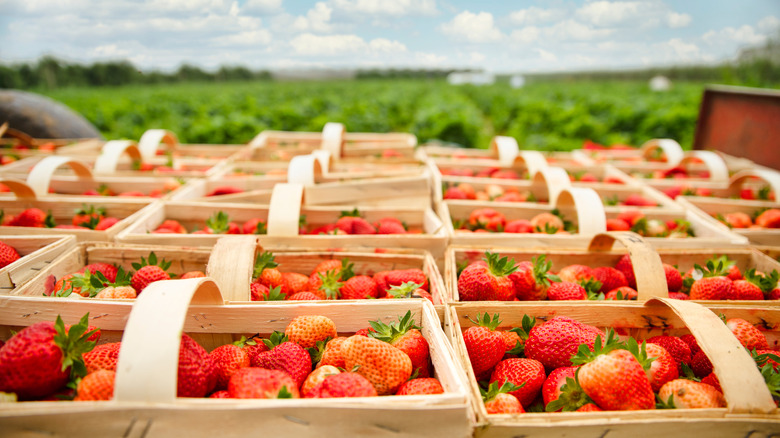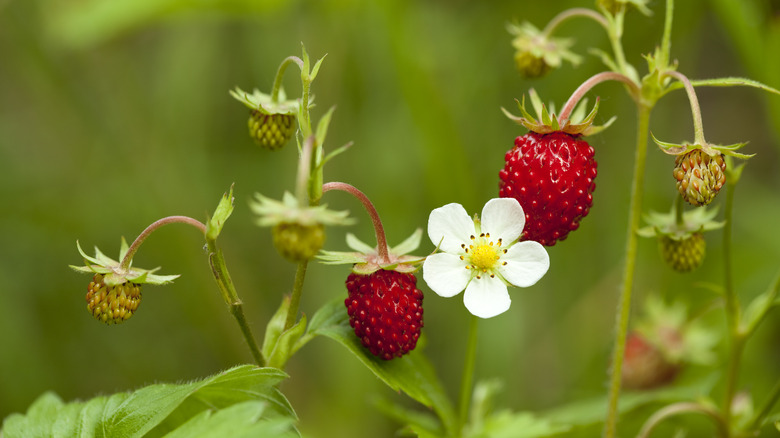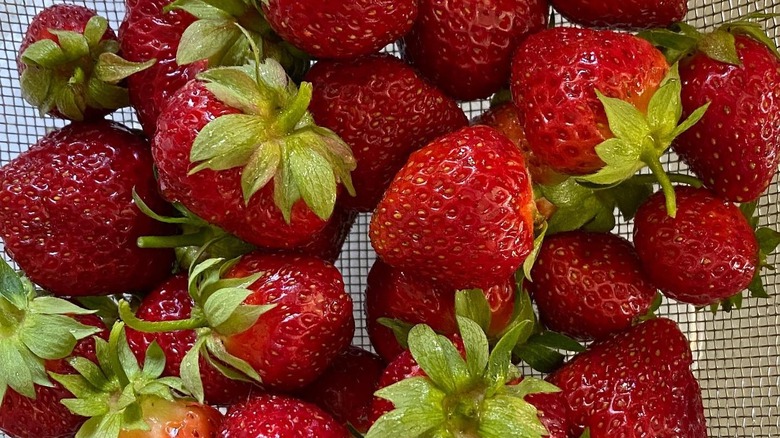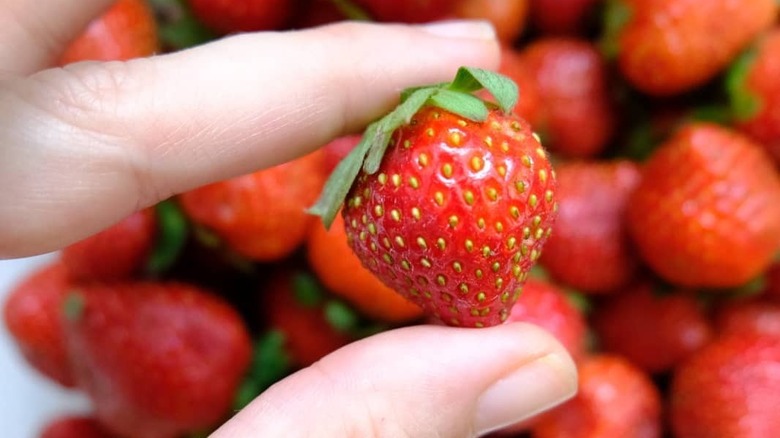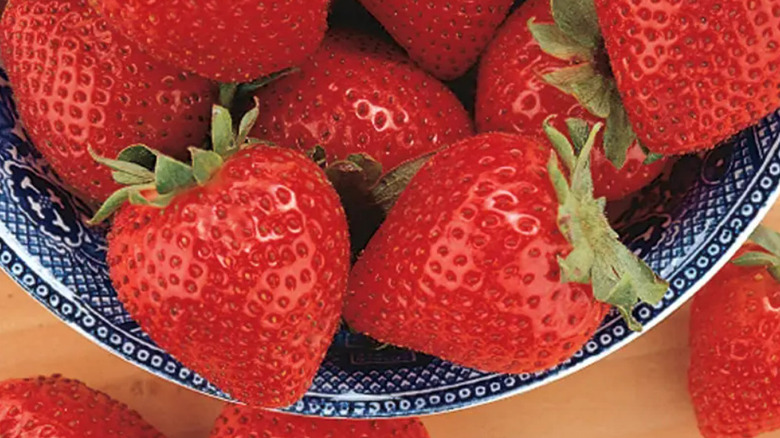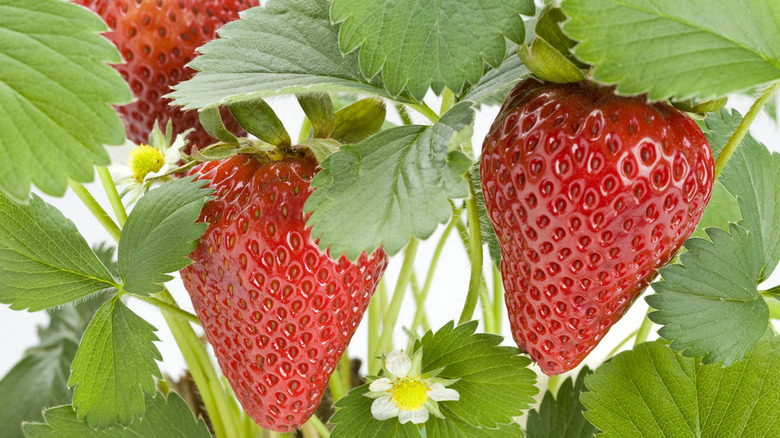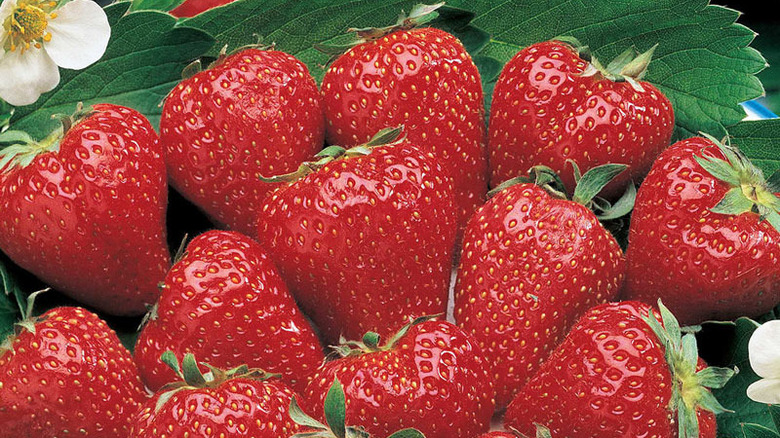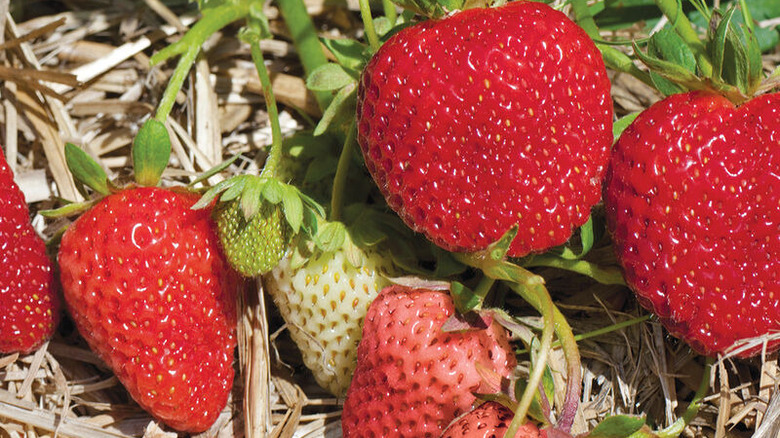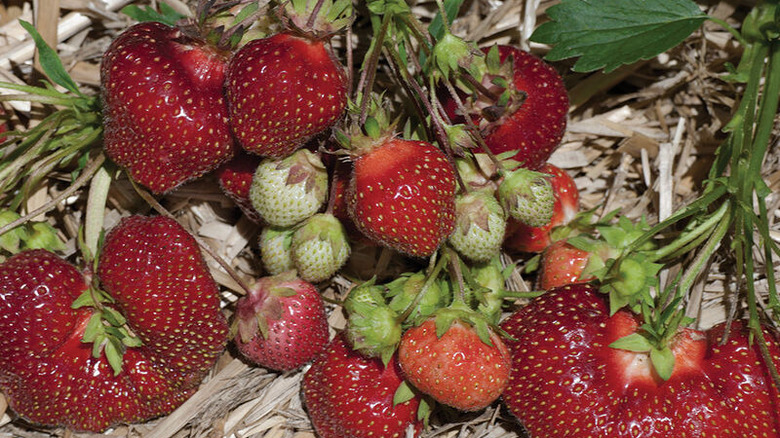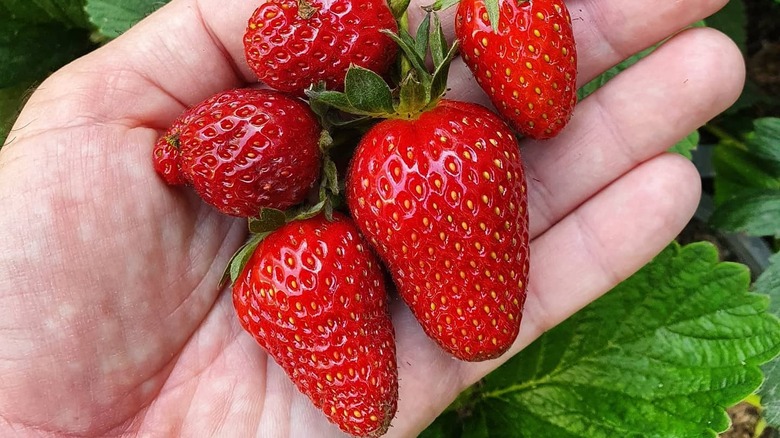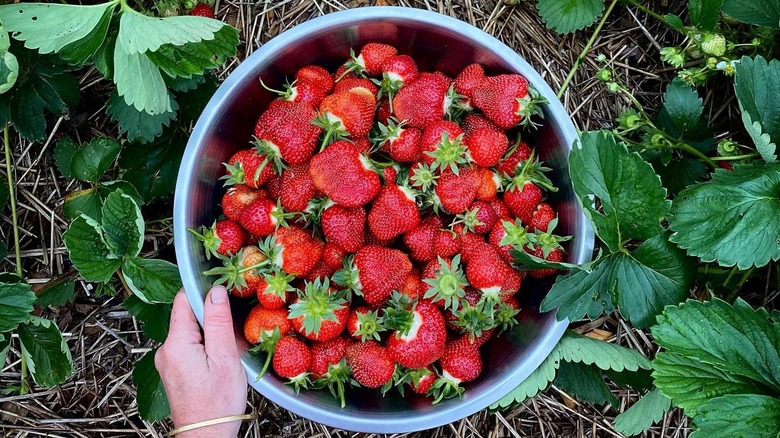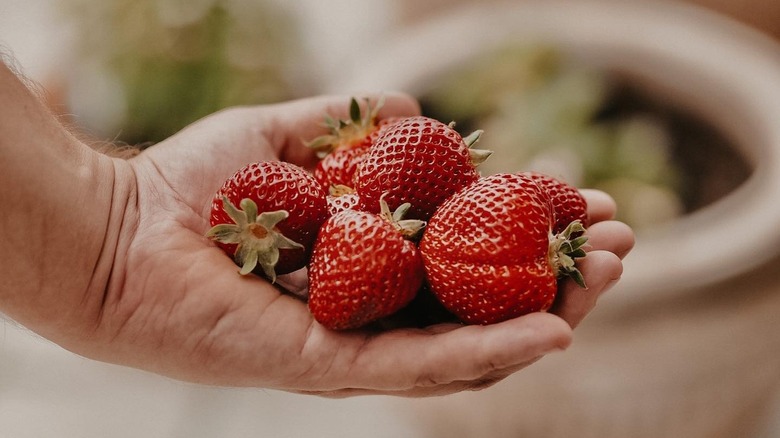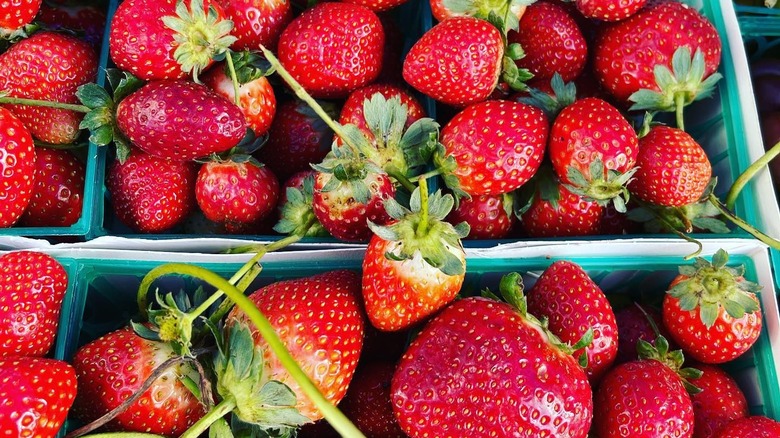13 Strawberry Varieties You Might Not Be Aware Of
Did you know there are more than 100 species and subspecies of strawberries? While there are only three actual types of strawberries — everbearing, June-bearing, and day-neutral — there is a range of berries within each category, with new variations coming out every year as more are bred. The difference between these three types of strawberries comes down to how, where, and when they are grown and harvested.
However, the countless varieties come down to flavor, color, size, and production rate. Some strawberries are sweeter, some are tart, and some are massive while others are tiny with a big punch of flavor. While all strawberries are a great source of vitamin C and antioxidants, it can be helpful to know what kind you are buying or planting. Because they can be very unalike, they will yield different results in harvests and recipes.
Next time you search for the biggest, brightest berry hoping it will be juicy and sweet, remember that it actually comes down to what it is. Here, you'll learn about some popular strawberry varieties you might not have heard of, and how they differ from one another.
1. Alpine
The tiny Alpine strawberry is often found growing naturally in the wild, and it is great for gardening. Because it is a day-neutral type of strawberry, it grows no matter how much sunlight it gets. If you forget to water them for a few days, or it doesn't rain as often, they'll likely survive it as they are rather resilient. Still, alpine strawberries do their best growing during strawberry season – they are perennials but will die off in the winter before returning in the spring.
Alpine strawberries also come in other varieties, such as Alexandria Alpine or Yellow Wonder Alpine, but they are all classified as Fragaria vesca. Fun fact: The common alpine strawberry was found in the Alps, which is how it got its name. This kind of woodland berry is usually quite a bit smaller than the hybrids found in grocery stores or farmer's markets. Nevertheless, they are packed with flavor and are very rich, sweet, and fragrant. Truly, these baby berries are some of the sweetest strawberries you'll find.
2. Ozark Beauty
One of the most adaptable everbearing strawberries, this cultivar is very popular commercially. Ozark Beauty strawberries produce very large and robust berries in abundance. They're also fairly easy to plant, which makes them a good choice for beginners. Since they are everbearing, you may see a late harvest beyond the typical strawberry season. Additionally, they can withstand colder temperatures, meaning they can be planted in several regions.
Like most everbearing varieties, these berries aren't very firm, so they can bruise easily when you are picking them. When Ozark Beauty strawberries are fully ripe, they are red throughout with a sweetness that isn't overwhelming. Their honey-sweet flavor makes them ideal for home recipes like strawberry jams, jellies, or pies. Furthermore, they are suitable for canning, freezing, or just good old snacking. Overall, these strawberries are vigorous and full-flavored, and much larger than most everbearing varieties, making them understandably popular.
3. Sweet Charlie
Developed in Florida and the most popular variety grown commercially in the state, Sweet Charlie strawberries are June-bearing and thrive across the United States, primarily in the South. Like other cultivars, this plant loves getting plenty of sunlight and water. Despite being a June-bearing variety, a second crop of large Sweet Charlie strawberries can grow during the last week of the season, giving you another chance to reap the benefits.
Known for their incredibly sweet taste, these small berries have a delicious flavor with low acid. When the tip of the strawberry has lost its orange color and reddened, they are ready to harvest. Just like several cultivars, Sweet Charlie berries are appealing to butterflies, bees, and birds, but you can use bird netting to deter the latter. This variety of strawberries is a good choice for home gardeners because they grow well in containers and are easy to care for.
4. Tristar
With the pretty, little white flowers that bloom alongside the fruit, Tristar strawberries are a popular variety for indoor planting or outdoor harvests. Because they are self-fertilizing and bloom repeatedly, they are very productive and easy to grow, and are done so throughout the United States. But they also grow well in containers, making them ideal for hanging planters in your house or on your porch. This day-neutral berry loves the sun, but it won't care when it starts to go down early -– it'll keep on sprouting. However, Tristar strawberries don't fair well in the shade or when it's too wet, so it may be best to plant them in a covered area if it rains often.
Tristar strawberries are firm and small to medium in size, with a sweet and sometimes tangy flavor. Glossy, bright red, and conical-shaped, they are beautiful to look at and delicious to eat. Partly because of their flavor and partly because they grow in large quantities, this variety is good for bulk use like making preserves or freezing.
5. Chandler
A popular variety with growers in Southern California, Chandler strawberries are June-bearing and have the highest yields in the coastal states; they also do well in home gardens. Chandler strawberries weren't bred for their shelf life, so they aren't often found in grocery stores. However, you may find them at your local farmer's markets or at fruit stands.
Because of their limited availability, it is a good idea to try planting this variety in your home garden. Make sure to wait until there isn't any frost on the soil, or they won't grow very well. While they are resistant to many insects, they are prone to disease and they attract slugs when they are ripe. These berries usually ripen from mid-June to early July and produce large, very juicy fruit. Sometimes they are long, and often they are the classic conical shape. With their bright red color and delicious flavor, these juicy strawberries are excellent in smoothies.
6. Surecrop
Compared to other June-bearing varieties, Surecrop strawberries are bound to produce a large harvest, earning this variety its name. Sometimes irregular in size and shape, these berries are firm and deep red with yellow seeds. Most June-bearing strawberries are larger in size, and Surecrop strawberries are no exception. Harvests typically deliver berries that are medium to large in size. In general, they are a very robust variety. Tart and sweet, they are ideal for canning, desserts, and preserves. Like its name suggests, Surecrop strawberries can be grown in many regions and many types of soil but prefers sandy loams.
Some say these strawberries are high maintenance while others say they are low maintenance, but in any case, they require full sunlight and do their best blooming from May to June. As are several other strawberries, the Surecrop variety is self-pollinating and a productive grower. They are also able to withstand colder weather, and are rather disease-resistant.
7. Albion
Generally grown in California, Albion strawberries are a hybrid with a lineage of Diamante and Cal 94.16-1. Resembling both its parent Diamante and Camarosa, this variety produces large, firm, symmetrical fruit that has a darker red color inside and out. With its large size and sweet flavor, an Albion strawberry is delicious in desserts or enjoyed fresh plain or with a dollop of whipped cream.
They are extremely tolerant of heat and humidity and produce a high yield when they are well-watered. In the Mid-Atlantic area, these berries deliver a lower yield but are still of good quality. Both everbearing and day-neutral, Albion strawberries endure in long, hot summers and well into the fall. Because they are low-maintenance and grow extremely large berries at a quick rate, they are a favorite of gardeners. If you plant this everbearing variety in a garden bed, know that they will last for one to two years and there isn't a need to replant them.
8. Earliglow
Low-maintenance and perfect for beginners, Earliglow strawberries produce high yields in home gardens and are often found at locations where you can pick your own strawberries. As its name suggests, this June-bearing variety starts harvesting early and grows for a few weeks from June to July. However, the size of the berries will decrease as the season ends, so it can be helpful to plant these alongside an everbearing variety to encourage a staggered harvest. Although they slow down as the summer months end, they produce an abundance of runners, so future harvests are usually more bountiful.
These berries are adaptable in many regions as they are frost-resistant, but they do love exposure to full sun. When growing them at home, you'll get the best results in garden beds and containers. It's best to keep them outdoors, as they likely won't get the sun they require when they are inside.
Earliglow strawberries are usually medium-sized, very sweet, and juicy. They are great for freezing, eating fresh, adding to a strawberry spinach salad, and making pies and preserves.
9. Sequoia
Sequoia strawberries are adaptable to most regions, and although they were developed in California, they are ideal for Southern states and gardens in warm climates. While they need the summer shade, they also tolerate frost and are hardy in cold temperatures. These hybrid berries are usually planted as perennials, but can sometimes be planted as annuals when the region is outside of the USDA plant hardiness zones 4-8. Albeit, these zones cover a large part of the map, confirming that this variety can easily grow in many places.
This variety is June-bearing and matures early, but picking Sequoia strawberries frequently can encourage growth because they are willing to flower for an extended time. However, they are tender when they are ripe, so these berries aren't great for commercial use — they can lose quality or bruise when they are shipped. Sequoia strawberries are super sweet, juicy, and aromatic, so they are great for desserts or eating fresh.
10. Camarosa
Similar to the Chandler variety, Camarosa strawberries are the main variety grown in California and shipped across the country to supermarkets. What differs between this variety and Chandler strawberries is that these June-bearing berries produce even earlier than most, making them ready for harvest at a fast pace. Another difference is the higher yield that comes from Camarosa strawberry plants.
This cultivar does well in hot and dry climates, or in indoor containers that can be relocated in inclement weather. But they still survive in many regions (USDA zones 4-10) and last during the winter.
Because they grow such large and firm berries, Camarosa strawberries keep for a long time and hold up well when shipping. Therefore, it is a popular choice for commercial growers. You are more likely to see strawberries that resemble this variety when shopping at the grocery store and can even find them in store-bought strawberry jams. When the berries ripen to a deep red and lose their glossy shine, they're at their peak flavor.
11. Jewel
Known for its beautiful appearance, the Jewel variety produces big, juicy, deep red, wedge-shaped strawberries. These jewel-toned and intensely sweet berries are aromatic and delicious. Bred in New York, this June-bearing cultivar thrives in Northeastern and upper Midwestern states; but it is also adaptable to many climates and able to withstand a cold spell or extreme weather conditions. While they are rather disease-resistant, this variety is still susceptible to gray mold, fruit rot, root rot, or foliage disease. However, they are durable and good for shipping and storing in the freezer.
As perennials, Jewel strawberry plants will bear fruit for around three to five years. This consistency in harvests makes it a preferred choice for home gardeners. Since they typically produce one large harvest between June and July, this variety is ideal for gardeners who like to harvest in bulk and store the berries for preserves, freezing them for smoothies, or simply eating them fresh.
12. Honeoye
One of the biggest producers of strawberries, the Honeoye variety is very popular. Few other cultivars can deliver more berries than these. For both home gardeners and large-scale production, this variety is one of the top-ranked choices. Because they are incredibly resistant to cold temperatures, Honeoye strawberries are more unique than other June-bearing plants. Additionally, they are day-neutral so they aren't sensitive to a day's length. It's imperative to keep these plants healthy and maintained, as they can be affected by soil disease. You should also avoid planting them in areas where peppers, potatoes, tomatoes, okra, or eggplants were previously planted, as they can be susceptible to the same kind of diseases. But with plenty of water and care, Honeoye strawberries will have a plentiful harvest.
Varying from bright orange-red to red in color, these firm berries have a homegrown strawberry flavor. Their strong taste makes them perfect for strawberry margaritas, baked goods like pies or cobbler, or as a topping on salads. For the ultimate indulgence, dip them in chocolate.
13. Seascape
Compared to other everbearing and day-neutral strawberries, the Seascape variety has a prolific harvest. With their conical, quintessential strawberry shape, they are both pretty and tasty. Not overly sweet and just a little tart, this variety is a prime choice for snacking and making preserves. You might not find them in the grocery store, but these berries are often found at farmer's markets or roadside fruit stands. Every season, it produces a crop in both the spring and the fall.
Despite being developed in California, it grows well in the Mid-Atlantic region. In fact, this cultivar is one of the most widely grown, as far as everbearing varieties go, in the eastern U.S. and in Canada. While they love access to full sun and can live in temperatures up to 90 degrees Fahrenheit, the shade can be beneficial during particularly hot summers. As winter approaches, they can tolerate some frost and are cold-hardy. With their adaptability, sweet flavor, and beautiful shape, this high-yielding variety is ideal for growing alongside blackberries, blueberries, coneflowers, or roses.
